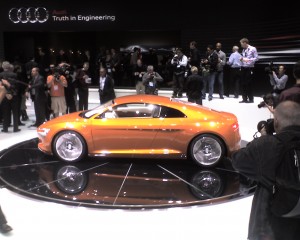 A new National Academies report analyzes cost, adoption, and emission implications for plug-in hybrids in comparison to hybrids.
A new National Academies report analyzes cost, adoption, and emission implications for plug-in hybrids in comparison to hybrids.
This report considers two vehicles. One, the PHEV-10, uses plug-hybrid electric vehicle (HEV) technology similar to that used in the Toyota Prius Plug-in. However, it has a larger battery than an HEV to allow 10 miles of driving powered by electricity only and a gasoline engine that drives the wheels in parallel with the electric motor when power demand is high or the batteries are discharged. The other vehicle, the PHEV-40, is similar to the Chevrolet Volt. It has a 40-mile electric range, a larger electric motor, and a much larger battery than the PHEV-10.
The cost to the manufacturer of producing the first generation of the PHEV-10 (2010–2012) is expected to be about $6,300 more than that of the equivalent conventional midsize car (non-hybrid), including $3,300 for the battery pack. Similarly, the PHEV-40 with a $14,000 battery pack would cost about $18,100 more. These cost differences would be smaller if the PHEVs were compared to equivalent HEVs, but the fuel savings would be smaller.
Unlike semiconductors, fast drops in energy storage cost are not expected. The study did not appear to consider greater range with less battery cost due to significant drops in vehicle weight due to new designs and materials.
PHEVs show less improvement in GHG emissions than in gasoline consumption because of the additional emissions from electricity generation. The report did not appear to consider significant future cost decreases in renewables, nor RPS mandates in 30 states.
Assembled battery packs currently cost about $1,700/kWh of usable energy. A PHEV-10 will require about 2.0 kWh and a PHEV-40 about 8 kWh even after the batteries have undergone expected degradation over time. Costs are expected to decline by about 35 percent by 2020 but more slowly thereafter.
Should gasoline stay under $4 per gallon, the report does not expect PHEV-40 to be cost-effective until 2040 and PHEV-10 until 2028.
Thirteen to 40 million PHEV out of 300 million total vehicles are projected to be on the U.S. roads by 2030 under different scenarios. In other words, the report forecasts more gasoline burning vehicles that at present.
Even at 40 million, the grid is expected to easily support the plug-in electric cars if they are charged at night.
You can download a free 29 page summary of the Transitions to Alternative Transportation Technologies–Plug-in Hybrid Electric Vehicles or purchase the $28 report.
